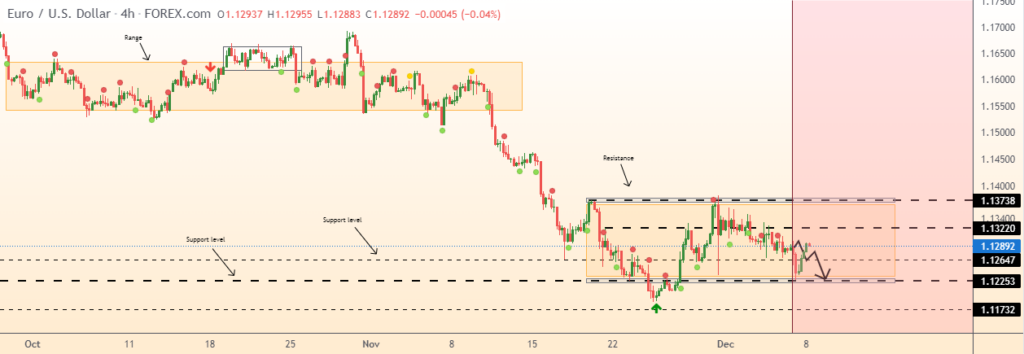
- US dollar under pressure at 16-month highs
- EURUSD bounces back on dollar softness
- USDCAD under pressure on rising oil prices
The US dollar came under pressure Wednesday morning, pulling back against the majors after recent rallies to 16-month highs. Weakness on the greenback comes amid an uptick in risk appetite amid easing fears over the potential impact of the Omicron variant.
Reports that the new Covid variant is less severe even though the current vaccines cannot offer full protection saw investors turn their attention to heavily battered majors. The dollar index, which measures the greenback strength against the majors, edged lower to 96.13 after touching highs of 96.658 on Tuesday.
EURUSD technical analysis
The renewed dollar weakness is the catalyst fuelling the EURUSD bounce back after the recent sell-off. The pair has since bounced back to 1.1290, with bulls eyeing the pivotal 1.1300 psychological level. 1.1299 is the immediate short-term resistance level standing in the way of the pair trading above the 1.1300 level.

On the flipside, 1.1260 is the support level above which EURUSD looks set to continue edging above. A breach of the 1.1260 support level could trigger a drop to 17-month lows of 1.1180.
EURUSD drivers
The EURUSD is going higher, benefiting from softer US treasury yields that continue to fuel dollar weakness. The 10-year yield has already dropped to lows of 1.46% after a deep pull back from 1.70%. The lack of Federal Reserve rate hike signals this week also underpins dollar softness after recent rallies.
The Federal Open Market Committee (FOMC), which is expected to decide on the fate of rate hikes in the US, has already entered into a silent period ahead of next week’s pivotal meeting. However, traders’ attention should be drawn to the US consumer Price index on Friday, likely to weigh heavily on treasury yields, consequently dollar strength, and EURUSD price action.
Additionally, EURUSD bulls remain supported by the indecision of the European Central Bank policymakers. The ECB governing council member Madis Muller insists it is not obvious that they will add to the current Asset Purchase Program in light of the runaway inflation.
The lack of major economic data signals risks catalysts as the main driver of the EURUSD pair heading into next week. Receding Omicron concerns should continue to offer support to riskier pairs such as the Euro.
USDCAD pull back
Meanwhile, USDCAD edged lower, pulling back from highs of 1.2869 at the start of the week. The pair is currently flirting with two-week lows near the 1.2649 level, helped by an uptick in oil prices that continues to offer support to the Canadian dollar.

After the deep pullback, USDCAD is staring at strong support near the 1.2620 level. A break below the support level could trigger renewed sell-off to 1.2510, the next substantial support level. On the flip side, a bounce-back above the 1.2711 level could result in a rally to highs of 1.2800.
The sell-off on USDCAD comes on oil prices powering through the $70 a barrel level, all but fuelling Canadian dollar strength. Oil prices have been edging higher in recent days amid easing fears that the Omicron variant will trigger restriction measures, consequently affect demand.
With demand expected to continue edging higher amid low supply, oil prices look set to continue edging higher, something that should work in favor of CAD strength against the greenback. Consequently, the USDCAD pair could continue edging lower.
In addition, softness on the US dollar amid strong demand for riskier assets on receding Omicron fears continues to influence the sell-off on the USDCAD pair. Nonetheless, things could change come next week as the FOMC meeting minutes hit the wires.








Leave a Reply